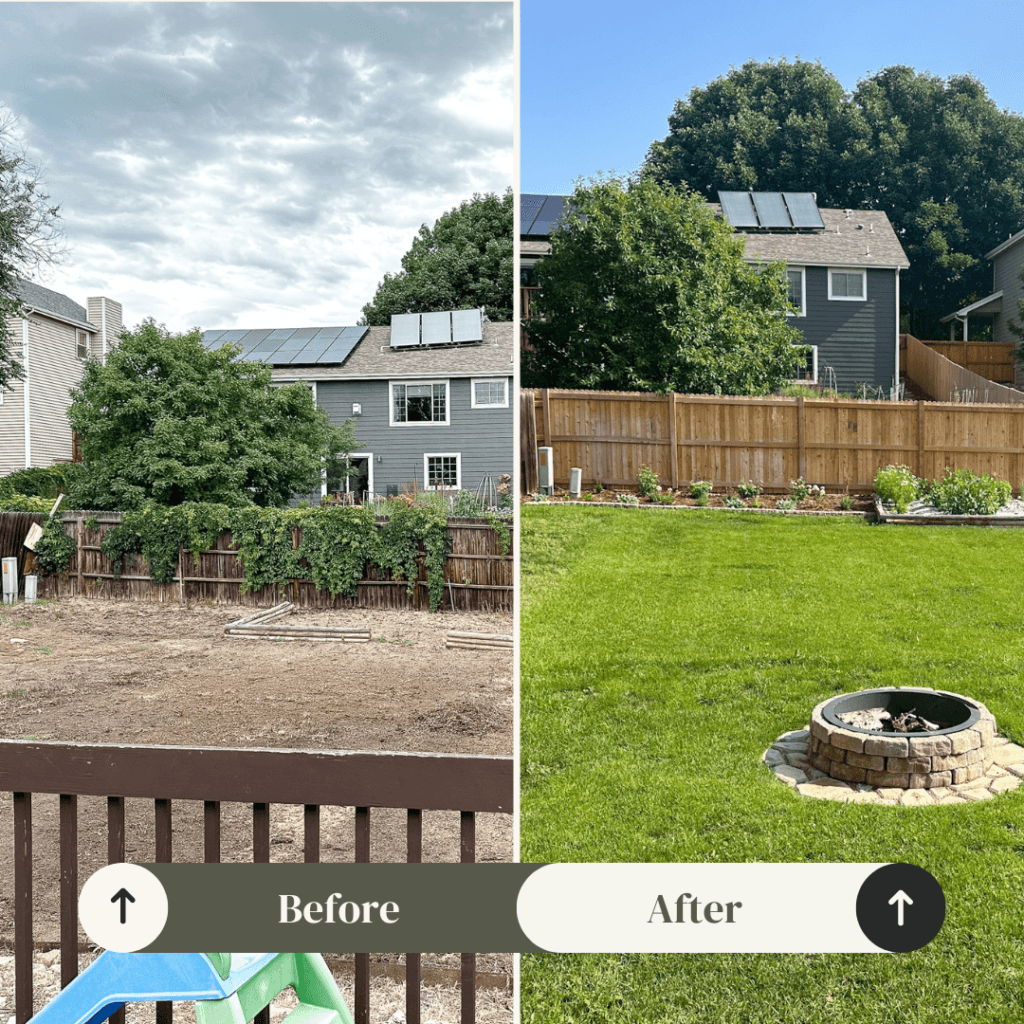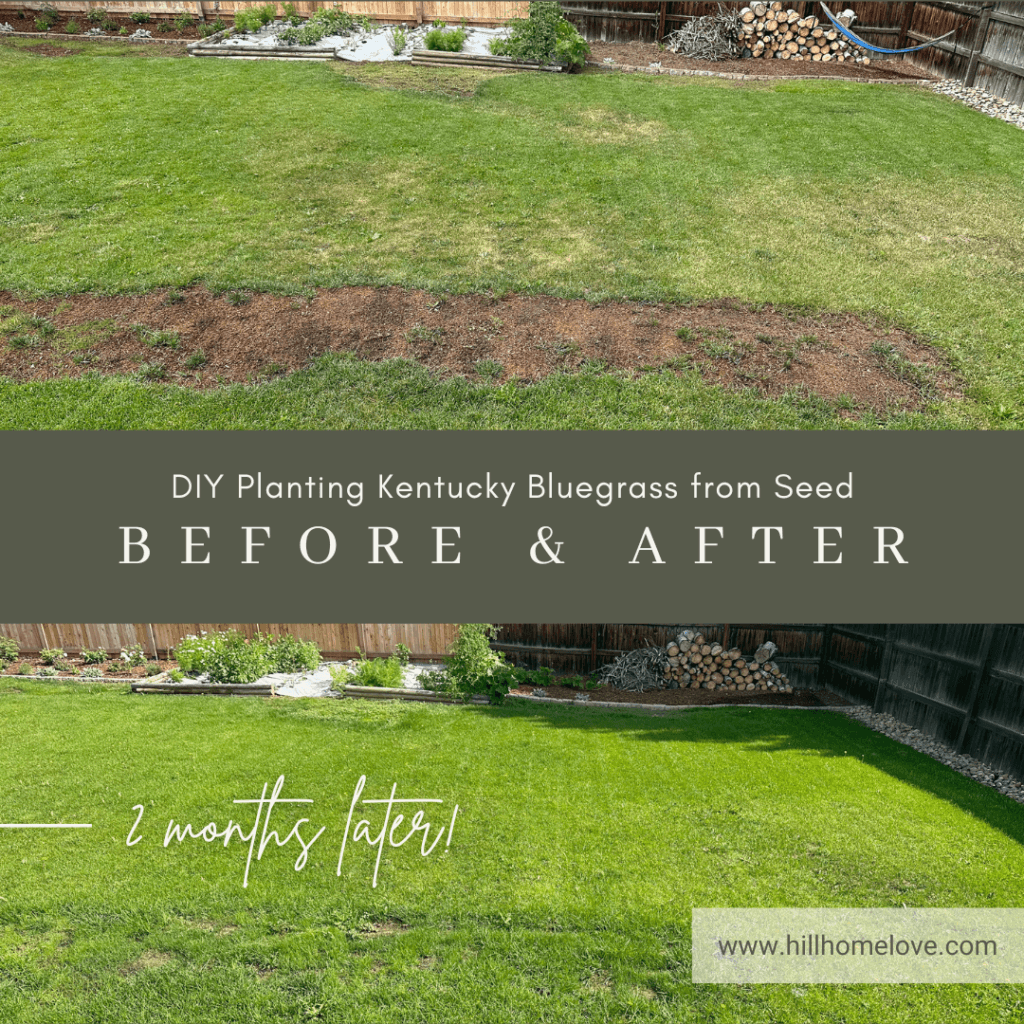In just two summers we’ve transformed our backyard from a trashed dirt pile into a lush Kentucky Bluegrass lawn. If you’re looking for the basic steps to plant grass from seed, here’s a quick overview of how we did it! All the basics for germinating kentucky bluegrass in your own yard.

Tools & Materials Needed
- Seed Spreader
- Metal Rake
- Sprinklers
- Kentucky Bluegrass Seed
Time: 2+ Hours
Difficulty: Beginner Friendly
Germinating Kentucky Bluegrass Step-by-Step
This is a quick overview of the seed planting process. For longer explanations head to this post! For an even shorter overview, jump to this section.
1: Remove weeds and dethatch.
Mow any existing grass on the shortest setting. Remove excess weeds, without using a weed spray as it can harm grass seed germination. Using a metal rake, dethatch your lawn to create better airflow for the new grass to grow. Aerating your lawn in the early spring will help with this too.
2: Till the soil.
Loosen the top 1″ of dirt so that the grass seed can enter the surface of the soil easily. This will keep the grass seed from blowing around in the wind, and ensure proper germination.

3: Spread the grass seed.
Next, use a manual seed spreader to evenly distribute a layer of grass seed. Working in sections, lightly till the soil again so the seed will go just below the soil’s surface.
4: Water consistently.
You need to keep your lawn moist in order for the grass seed to germinate. Check your local area’s watering recomendations.
For us in Northern Colorado, we set our sprinklers to run every morning at 6am and every night at 8pm for 10 minutes per zone. Each spinkler system is different so this may be too much or too little for your lawn.
Once your grass has sprouted, you can lower your sprinkler times/amount.

Germinating kentucky bluegrass can take up to 4 weeks. Wait to mow your new grass until it’s about 4 inches tall.
5: Keep up with maintenance.
Keep up with preventative weed killer and lawn fertilizer each season. This will help your new lawn become more established and come back even more lush each year. Avoid letting your grass grow excessively long which can contribute to thatch build up.
Germinating Kentucky Bluegrass Seed FAQ
We’ve learned a lot after planting our entire yard with new grass seed. These are the questions we found ourselves searching answers for and figured out along the way.
“When should I plant Kentucky Bluegrass seed?”
Spring planting is ideal after the last frost. But later in summer might be okay. By the time our yard was prepped and ready last year, we planted grass seed in the heat of August. The heat can make it harder to germinate, so make sure you keep watering enough each day! It still took really well for us.
“Why is my new lawn patchy?”
This is totally normal. Give it some time and the rest will most likely fill in! You may need to adjust your sprinklers to help. Kentucky Bluegrass spreads at the roots and naturally thickens with time.
“How long does germinating Kentucky Bluegrass take?”
Germinating Kentucky Bluegrass took about 4 weeks. We saw little sprouts start to appear about 2 weeks after planting, but it can take longer.
“When can I walk on and mow the new grass?”
Try to stay off the grass until it’s at least 2 inches tall. You don’t want to damage the little sprouts. Wait until your grass is about 4 inches tall or more before mowing.
“Why are there so many weeds sprouting with our new grass?!”
Take it as a sign that you’re watering correctly and your lawn is perfect for growing. I know those weeds ae annoying, but it’s totally normal to see weeds sprout alongside your new grass. You can hand pull them out. But know that the thicker your grass gets, the less weeds you’ll have!
Make a plan to deal with those weeds once your new grass is a little more mature. You can use a grass-friendly weed killer. Plan to put down a weed killer in the fall as your lawn begins to go dormant. And another pre-emergent weed preventer in the spring before your grass starts to come back.
With time and attention, your lawn will be weed free pretty quickly.
Treating your new lawn for weeds in the future will significantly cut down on this problem too. We’re in our second summer with this new lawn, and we had a lot less weeds this year without even treating for it!
Troubleshooting Patchy New Lawns
It’s common for your new lawn to be patchy at first. Give it some time to fill in, but here are a few ideas that could help!
Use a mixed seed blend
Compared to other grasses, germinating kentucky bluegrass takes a lot longer. One option is to used a mixed grass seed. This can help fill in random bare spots in your lawn while the established kentucky bluegrass continues to spread.
Cover with straw
You can add a light layer of straw over the grass seed as a protective measure against birds or wind disturbing your new seeds. This also helps it stay moist, ensuring more sprouts and better germination rate. We chose not to do this but I think it would have really helped!
I don’t recommend doing this in the later summer though, as it can make the ground too hot which prevents the seed from germinating or growing.
Use a lawn patch repair
You can buy pre-mixed bags of lawn patch repair like this or this. Typically these include a blend of fast-growing grasses that can quickly fill in a bare patch, along with kentucky bluegrass seed. These usually include some kind of mulch filler that will help keep the seeds moist and on the ground. We did this in July to start new grass where we had removed landscaping. It worked great!
Keep watering, weeding, and fertilizing
Kentucky bluegrass naturally spreads on it’s own. Give it some time and you’ll see that it will fill in as it matures!
It can take 3 years for a new lawn to mature.
In the meantime, keep maintaining a healthy lawn with preventative weed killer, seasonal fertlizing, aeration, and appropriate watering.
Overseeding
You can overseed your lawn next season to help it all fill in. Be sure to repeat all the prep steps again before replanting.
Germinating Kentucky Bluegrass Overview
- Remove weeds and dethatch your existing lawn.
- Mow on the lowest setting.
- Till the top 1″ of soil to loosen it.
- Spread the grass seed and gently rake into the loose soil.
- Water consistently to keep soil moist.
- Be patient! Sprouts can take up to 4 weeks to appear.
Kentucky bluegrass is great for lawns because it’s drought tolerant, reslient, and spreads. Planting it from seed can save you thousands of dollars compared to installing sod. It just takes a little time and attention. Hopefully this quick guide can help you out!
For more info and before-and-afters of our own experience with germinating kentucky bluegrass, check out this longer post!




